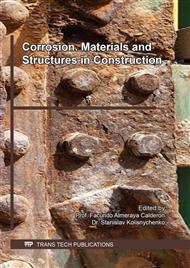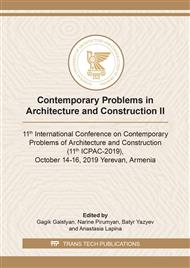p.141
p.146
p.153
p.158
p.163
p.170
p.180
p.194
p.202
Fire Resistance of Reinforced Concrete Corrosion-Damaged Columns of the "Standard" Fire
Abstract:
The article describes the features of the effect of corrosion of reinforcement on the bearing capacity of reinforced concrete columns in a "standard" fire. On the basis of the standard calculation method, the fire resistance of the column was estimated under a four-sided fire effect taking into account the different duration of the fire. The study examined the operation of the column in a corrosive environment, it was assumed that the initiation of corrosion of concrete and reinforcement will occur after 10 years of exploitation. It was found that the destruction of concrete protective layer 25 mm thick in a medium aggressive environment will occur after 25 years, and the diameter of the reinforcement during this period will decrease by 20%. To compare the results, a reinforced concrete column with a section of 400x400mm was calculated under the influence of a “standard” fire under normal operating conditions and taking into account work in a corrosive environment. The results of heat engineering calculations are presented, where the temperature changes in the reinforcement depending on the heating time and reduction of the protective layer thickness, as well as the change in the diameter of the reinforcement and its effect on the bearing capacity are shown. It has been established that reducing the cross-sectional area of the working reinforcement and reducing the cross-sectional dimensions of the column due to the occurring corrosion processes leads to a decrease in the fire resistance limit on the loss of bearing capacity by 58%.
Info:
Periodical:
Pages:
163-169
Citation:
Online since:
December 2019
Keywords:
Price:
Сopyright:
© 2020 Trans Tech Publications Ltd. All Rights Reserved
Share:
Citation:



